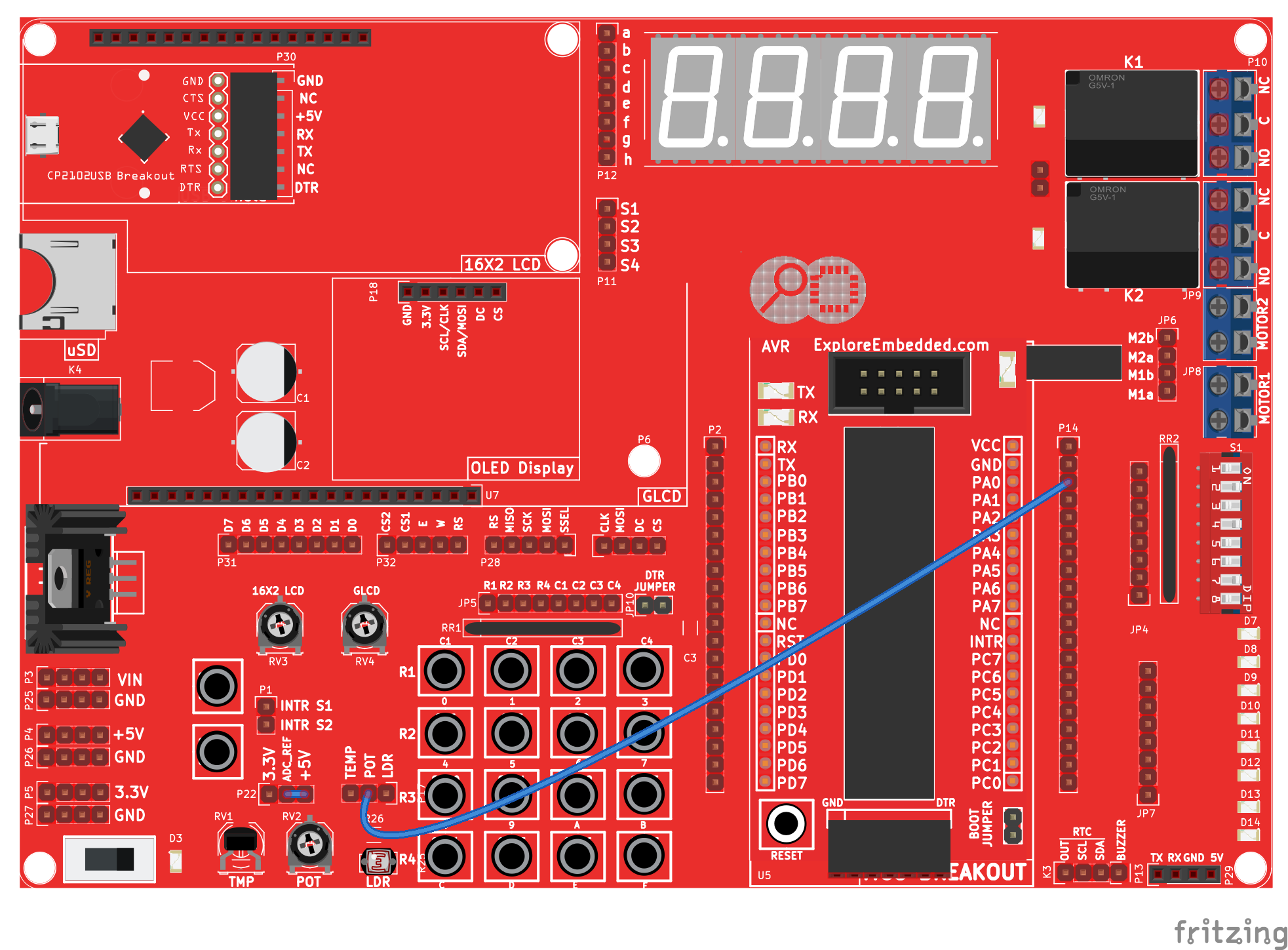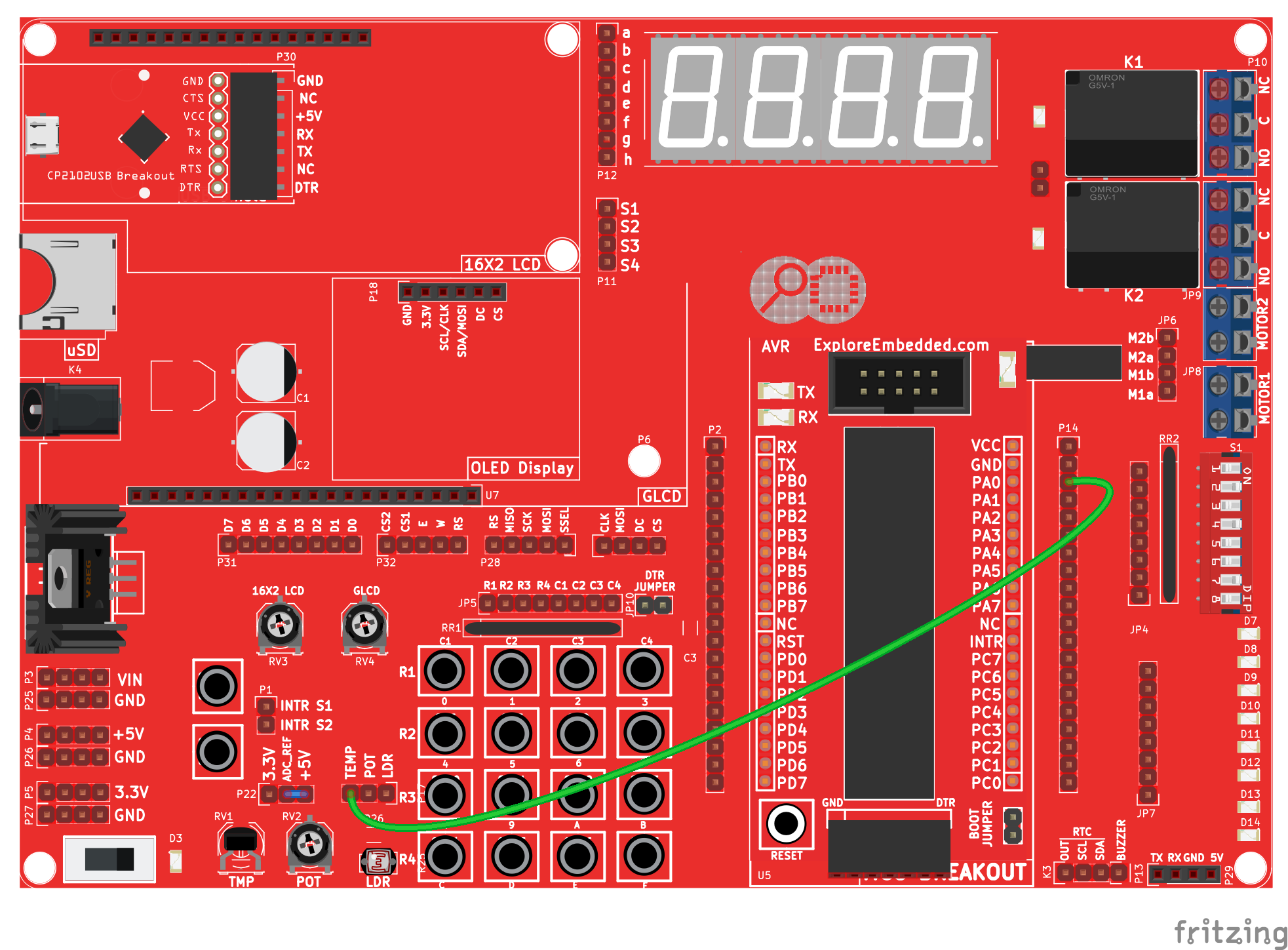Difference between revisions of "Reading Temperature with AVR ADC"
Raghavendra (Talk | contribs) |
Raghavendra (Talk | contribs) |
||
| Line 2: | Line 2: | ||
The Atmega32 comes with a 10-bit, 8 channel inbuilt Ananlog to Digital Convertor (ADC). We will set it up and read temperature from LM35 and light with a simple (light dependent Resistor)LDR. So let's get started! | The Atmega32 comes with a 10-bit, 8 channel inbuilt Ananlog to Digital Convertor (ADC). We will set it up and read temperature from LM35 and light with a simple (light dependent Resistor)LDR. So let's get started! | ||
=Basics= | =Basics= | ||
| − | The | + | The ADCSRA register allows us to enable the adc and set the sampling rate. |
| − | '''ADC Control and Status Register A ( | + | '''ADC Control and Status Register A (ADCSRA):'''<br/> |
{| class = "table table-responsive table-striped " | {| class = "table table-responsive table-striped " | ||
|- | |- | ||
| Line 12: | Line 12: | ||
|1||0||0||0||0||0||0||1 | |1||0||0||0||0||0||0||1 | ||
|} | |} | ||
| + | |||
| + | ♦ '''Bit 7 - ADEN: ADC Enable''' | ||
| + | |||
| + | Writing this bit to one enables the ADC. By writing it to zero, the ADC is turned off. | ||
| + | |||
| + | ♦ '''Bit 2:0 - ADPS2:0: ADC Prescaler Select Bits''' | ||
| + | |||
| + | These bits determine the division factor between the XTAL frequency and the input clock to the ADC. | ||
| + | |||
| + | '''ADC Prescaler Selection''' | ||
| + | {| class="wikitable" | ||
| + | |- | ||
| + | ! ADPS2 !! ADPS1 !! ADPS0 !! Division Factor | ||
| + | |- | ||
| + | | 0 || 0 || 0 || 2 | ||
| + | |- | ||
| + | | 0 || 0 || 1 || 2 | ||
| + | |- | ||
| + | | 0 || 1 || 0 || 4 | ||
| + | |- | ||
| + | | 0 || 1 || 1 || 8 | ||
| + | |- | ||
| + | | 1 || 0 || 0 || 16 | ||
| + | |- | ||
| + | | 1 || 0 || 1 || 32 | ||
| + | |- | ||
| + | | 1 || 1 || 0 || 64 | ||
| + | |- | ||
| + | | 1 || 1 || 1 || 128 | ||
| + | |||
| + | |} | ||
| + | |||
| + | |||
| + | |||
| + | |||
| + | |||
We will first initialize the ADC with the following code | We will first initialize the ADC with the following code | ||
# Enable ADC by Setting ADEN bit of ADCSRA and set the sampling frequency to half of oscillator frequency (i.e 8 MHz) | # Enable ADC by Setting ADEN bit of ADCSRA and set the sampling frequency to half of oscillator frequency (i.e 8 MHz) | ||
Revision as of 12:10, 28 March 2016
The Atmega32 comes with a 10-bit, 8 channel inbuilt Ananlog to Digital Convertor (ADC). We will set it up and read temperature from LM35 and light with a simple (light dependent Resistor)LDR. So let's get started!
Contents
Basics
The ADCSRA register allows us to enable the adc and set the sampling rate.
ADC Control and Status Register A (ADCSRA):
| 7 | 6 | 5 | 4 | 3 | 2 | 1 | 0 |
| ADEN | ADSC | ADATE | ADIF | ADIE | ADPS2 | ADPS1 | ADPS0 |
| 1 | 0 | 0 | 0 | 0 | 0 | 0 | 1 |
♦ Bit 7 - ADEN: ADC Enable
Writing this bit to one enables the ADC. By writing it to zero, the ADC is turned off.
♦ Bit 2:0 - ADPS2:0: ADC Prescaler Select Bits
These bits determine the division factor between the XTAL frequency and the input clock to the ADC.
ADC Prescaler Selection
| ADPS2 | ADPS1 | ADPS0 | Division Factor |
|---|---|---|---|
| 0 | 0 | 0 | 2 |
| 0 | 0 | 1 | 2 |
| 0 | 1 | 0 | 4 |
| 0 | 1 | 1 | 8 |
| 1 | 0 | 0 | 16 |
| 1 | 0 | 1 | 32 |
| 1 | 1 | 0 | 64 |
| 1 | 1 | 1 | 128 |
We will first initialize the ADC with the following code
- Enable ADC by Setting ADEN bit of ADCSRA and set the sampling frequency to half of oscillator frequency (i.e 8 MHz)
- Select channel zero by default using the ADMUX register shown below.
ADC Multiplexer Select (ADMUX)
| 7 | 6 | 5 | 4 | 3 | 2 | 1 | 0 |
| REFS1 | REFS0 | ADLAR | MUX4 | MUX3 | MUX2 | MUX1 | MUX0 |
| 0 | 0 | 0 | 0 | 0 | 0 | 0 | 0 |
void ADC_Init() { ADCSRA=(1<<ADEN) | (1<<ADPS0); /* Enable ADC , sampling freq=osc_freq/2 */ ADMUX=0x00; /* Result right justified, select channel zero */ }
Let us write another function to select the required channel and read the analog data as below :
- Select the required channel passed as input to the function
- Start the ADC conversion by setting ADSC bit in ADCSRA
- Wait till the conversion is over by checking the ADIF bit in ADCSRA
- Read the ADCW register and return the result of conversion
uint16_t ADC_GetAdcValue(uint8_t v_adcChannel_u8) { ADMUX = v_adcChannel_u8; /* Select the required channel */ DELAY_us(10); /* Wait for some time for the channel to get selected */ util_BitSet(ADCSRA,ADSC); /* Start the ADC conversion by setting ADSC bit */ while(util_IsBitCleared(ADCSRA,ADIF)); /* Wait till the conversion is over */ /* ADIF will be set once ADC conversion is complete */ return(ADCW); /* Return the 10-bit result */ }
Raw Data
Let's put all of the above together to read raw data from the ADC. We will connect a Potentiometer(Pot) to channel 0, vary it and read the raw voltage.
Hookup Pot
Code to Read Voltage
Temperature
Let's connect the LM35 temperature sensor to channel zero of the ADC and read the temperature. Resolution with 5V reference can be calculated as: $$ResolutionOfADC = (5v/1023)=4.887mv = 5mv$$ For every degree celcius the Lm35 provides 10mv voltage change, therefore $$Temperature = ADCValue/2 $$
Hookup LM35
Code to Read Temperature


